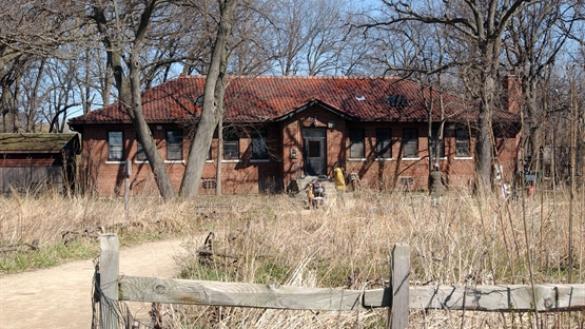As the Tuberculosis outbreak swept America in the late 1800’s, and carried into the 1950’s, the Chicago Municipal Tuberculosis Sanitarium stood as a haven of treatment and support for TB patients. Now, converted into the North Park Village Nature Center, it remains as a nature preservation and educational center for Chicago residents.
During the Tuberculosis outbreak of the 1950’s ― the busiest days of the sanitarium ― the nature center’s property and buildings once operated as a dispensary for patients, housing a chemist, a nurse and a small lab.
North Park Village is now a conglomerate of city administrative buildings, senior apartments, a health clinic, the Peterson Park, as well as the nature center and preserve.
Open-air cabins in the woods, where patients who didn’t require immediate care could live, were once scattered throughout the 46 acres of land now comprising the preserve. Patients living in the cabins could walk the trails through the woods or enjoy recreational amenities like the man-made pond or the maintained recreational fields, according to Liza Fischel, education naturalist for the Chicago Park District.
A little exploration of the complex reveals remnants of the sanitarium.
“The main loop trail was an old road that connected some of the buildings, and whenever they aren’t snow-covered, you can find sewers, sidewalks and foundations of the old buildings,” Fischel said.
Fresh air was actually prescribed to Tuberculosis patients by the physicians at the sanitarium because there was no real cure, but this incidentally sparked a movement that drew attention to the health benefits of natural environments and the importance of conservation.
“Patients had a buffer of trees and they had great food and exercise; It’s shocking that those are things we still strive to do in terms of our health and well-being today,” Fischel said.
Without the strength of the surrounding community, neither the center, nor preserve, would exist today.
After the last patients left in the 1970’s, the complex fell into dormancy before receiving offers for commercial development. There were plans for the plot to become a conglomerate of a shopping center and condominiums Bob Porter, landscape manager of the North Park Village Nature Center, said.
However, news of the development caught the attention of Joseph Cicero, former executive director of the North River Commission ― a group made up of about 100 smaller neighborhood organizations. Together, armed with the support of their community, they fought back.
Cicero organized a grass-roots campaign and gathered members to attend the meeting where former Mayor Richard Daley was to announce plans for development. According to Porter, Cicero made sure that the front row was lined with nuns from a local convent who opposed the development. They shouted the former mayor off the podium before he could even speak.
Due to the community backlash, Daley and the city threw out plans for the development, the grounds remained public and Cicero had succeeded.
Today, the nature center bustles with educational groups, events and local families enjoying the preserve. Fischel teaches several groups through the center. In one group, she teaches children how to safely tap maple trees for sap and explains the syrup making process. She is also involved in an outreach program with Chicago Public Schools’ third graders, among teaching other classes and coordinating events.
Porter and a group of volunteers are responsible for working twice a week to maintain the park grounds. Maintaining the land can be difficult with invasive species like the emerald ash borer around, the invasive insect which has killed most of the ash trees on the preserve. This means Porter and the volunteers have been cutting down the dead ash trees, chopping up the wood and using it for firewood.
“Fortunately, we have received a grant from Openlands ― an Illinois conservation advocacy group ― to plant 100 new trees,” Porter said.
Grants from organizations like Openlands and the individual effort of volunteers, help keep the preserve beautiful and functional.







Be First to Comment